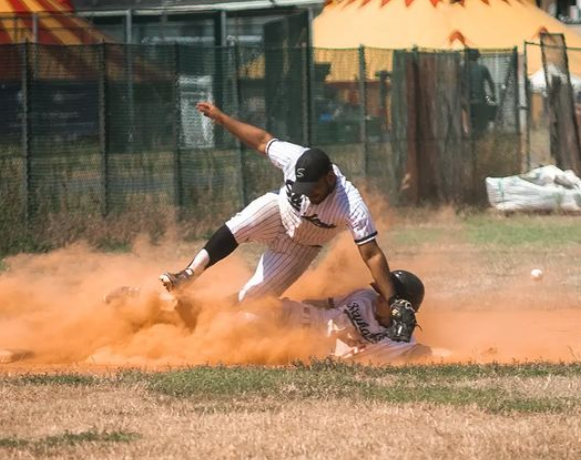In the game of baseball, understanding different types of outs is essential for both players and fans alike. The Force Out vs. Tag Out, are the two common types of outs that often create confusion. By examining their respective scenarios and requirements, one can better grasp the nuances of these plays in baseball.
A force out occurs when a baserunner is compelled to advance to the next base due to a batted ball, and a fielder retires the runner by either tagging the runner or the base toward which the runner is advancing with the ball in their possession. This type of out is most frequently witnessed when a ground ball is hit and the fielder throws the ball to the appropriate base before the runner reaches it, resulting in a force out.
Contrastingly, a tag out occurs when a baserunner is touched by a fielder with the ball or with the hand or glove holding the ball while the runner is not touching a base. Tag outs can happen in various situations, such as when a runner is attempting to advance on a hit, steal a base, or return to their original base. Unlike force outs, the baserunner is not required to advance during a tag out and can be retired by the fielder making physical contact with the runner and the ball.
Contents
Basic Concepts
Force Out
A force out in baseball is a fundamental concept that occurs when the defense records an out without having to “tag” a runner, catch a fly ball in the air, or strike out a batter. Instead, a force out happens when a fielder is able to retire a runner by holding the ball and touching the base to which the runner is forced to advance before the runner reaches that base. In this situation, two base runners cannot occupy the same base simultaneously, which results in a force out when the fielder steps on the base before the advancing runner.
Force outs occur in different scenarios, such as when there is a runner on first base and a ground ball is hit. The lead runner is forced to advance to second base, creating a force out opportunity for the defense.
Tag Out
On the other hand, a tag out requires the fielder to physically touch the baserunner with the ball or the glove or hand holding the ball, while the ball remains safely in the fielder’s possession. This is different from a force out, where it’s not necessary to touch the fielder directly with the ball.
Tag outs can happen in various situations, such as when the runner is not forced to advance to the next base, or when the runner tries to steal a base. The fielder’s aim is to touch the runner to call him out, without the need for him or the runner to touch the base.
Situations and Rules
Runner’s Obligations
In baseball, there are two main ways for a runner to be called out: force-out and tag-out. Understanding the differences between these two situations is essential for both fielders and runners to make successful plays.
A force-out occurs when a runner legally loses their right to occupy a base due to the batter becoming a runner. An example of a force-out is when a batter hits a ground ball to an infielder, who throws the ball to the first baseman before the hitter reaches the base.
On the other hand, a tag-out is when a fielder, while holding the ball in their hand or glove, touches a base runner who is not safe on a base. If the base runner steps off the bag at any point, they can be tagged out.
Fielder’s Responsibilities
Fielders must be aware of the specific rules and situations to make appropriate decisions when attempting to perform a force-out or tag-out. In a force-out, fielders need to touch the base while holding the ball before the runner reaches it. This usually involves infielders making swift and accurate throws to the baseman, especially in cases of potential double or triple plays.
In a tag-out situation, the fielder must physically touch the runner with the ball in their hand or glove when the runner is not in contact with a safe base. This requires fielders to be agile and attentive to base runners who might attempt to evade the tag.
Umpire’s Role
The umpire is responsible for making the final call on whether a force-out or tag-out has occurred. They must closely watch the play to ensure that the fielder has completed the necessary actions to execute the out. The umpire must also pay attention to the actions of the runner, ensuring they abide by the rules and stay within the designated base path.
It is essential for the umpire to have a thorough understanding of the rules in order to facilitate fair and accurate calls, ensuring that the game is played within the spirit of baseball.
Key Differences
Unforced vs. Forced
In baseball, the primary difference between a force out and a tag out lies in whether the baserunner is required to advance to the next base or not. A force play occurs when a baserunner must proceed to the next base due to a following runner or the batter becoming a runner. In such cases, the defense can retire the runner by tagging the next base before they arrive.
On the other hand, a tag out is when the baserunner is not required to advance and can be retired by a fielder physically touching them with the ball or the glove containing the ball. This usually occurs when there is no runner behind them forcing them to advance, and they attempt to advance at their own discretion.
Techniques
For force outs, the focus for the fielding team is on getting to the base before the runner. This typically involves a fielder fielding the ball and either stepping on the base themselves or making a quick, accurate throw to a teammate covering the base. The fielder must have possession of the ball and touch the base before the runner arrives to successfully execute a force out.
Tag outs, however, require a fielder to physically tag the runner with the ball or the glove holding the ball. This can involve chasing the runner, diving to make a tag, or setting up a strategic pickoff play. The primary goal is to touch the runner before they can safely return to a base or advance to the next one.
Risks
Force outs and tag outs each carry unique risks for both the offense and the defense. In force out situations, the defense must act quickly to reach the base before the runner. This can sometimes lead to rushed throws or missed catches, resulting in errors and potential scoring opportunities for the offense.
During tag outs, defensive players face the challenge of physically touching the baserunner, who may attempt to dodge or avoid the tag. This can lead to missed tags or accidental contact with the player rather than the base, potentially allowing the runner to continue advancing or remain on base.
For the offense, the risk in force out situations is that the runner might not reach the base in time, thus resulting in an out. Conversely, during tag outs, baserunners must be extra cautious when attempting to advance, as they can be easily retired if tagged by the defense.
Real-World Examples
Notable Force Out Plays
One memorable force out scenario is the standard double play. For example, with a runner on first base and a ground ball hit to the shortstop, the shortstop can step on second base to force out the baserunner, then throw to first base to force out the batter, completing a well-executed double play.
Another example of an impressive force out is the rare triple play. In this situation, three force outs are made during a single play. For instance, with runners on first and second bases and a ground ball hit to the third baseman, the fielder can step on third base for the first force out, throw to second for the second out, and complete the triple play by throwing to first base for the third and final out.
Notable Tag Out Plays
A well-known tag out play in baseball is the “pickle” or rundown. In this situation, a baserunner is caught between two bases and must be tagged out. The fielders involved in the rundown throw the ball back and forth while chasing the baserunner in an attempt to apply the tag before the runner reaches the safety of a base.
Another exciting tag out scenario is an outfield assist. In this play, an outfielder fields a base hit and throws the ball to a teammate who is positioned to make a tag at the desired base. For example, an outfielder may throw the ball from the outfield to home plate, where the catcher applies a tag on a runner attempting to score a run.
In both force out and tag out scenarios, the skills and communication amongst fielders play a significant role in successfully retiring the baserunners.
Conclusion
In the game of baseball, understanding the difference between force outs and tag outs is essential for both players and fans. Force outs occur when a defensive player retires a baserunner by touching the base before the runner does, while tag outs involve a fielder physically tagging the runner with the ball or a gloved hand containing the ball. Knowing when each type of out can be applied allows players to execute defensive strategies effectively.
Force outs typically come into play when there is a runner on base, and a ground ball is hit, which forces the baserunner to advance. In these situations, the fielder can record an out by simply stepping on the base with possession of the ball before the runner arrives. This is in contrast to tag outs, where the fielder must make direct contact with the baserunner to record the out, as seen in stolen base attempts or when a runner is caught off base.
Double plays and triple plays often involve a combination of force outs and tag outs, showcasing the importance of understanding the situations in which each can be used. Proper execution of force outs and tag outs can significantly impact games, turning potential big innings for the offense into quick, efficient outs for the defense.
By developing a strong grasp of the rules and strategies surrounding force outs and tag outs, players can become more versatile on the field and make crucial defensive plays. Fans, too, can gain a deeper appreciation for the game’s complexities and enjoy watching high-level competition unfold on the diamond.



